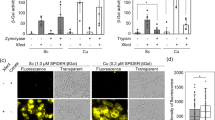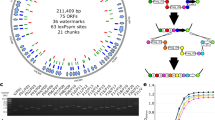Abstract
Here we describe a high-efficiency version of the lithium acetate/single-stranded carrier DNA/PEG method of transformation of Saccharomyces cerevisiae. This method currently gives the highest efficiency and yield of transformants, although a faster protocol is available for small number of transformations. The procedure takes up to 1.5 h, depending on the length of heat shock, once the yeast culture has been grown. This method is useful for most transformation requirements.
This is a preview of subscription content, access via your institution
Access options
Subscribe to this journal
Receive 12 print issues and online access
$259.00 per year
only $21.58 per issue
Buy this article
- Purchase on Springer Link
- Instant access to full article PDF
Prices may be subject to local taxes which are calculated during checkout
Similar content being viewed by others
Change history
20 November 2008
Note: In the version of this article initially published, in the Reagent Setup section on p. 32, the recipe for lithium acetate (1.0 M) called for 102 g of lithium acetate dihydrate. This should be 10.2 g. The error has been corrected in the HTML and PDF versions of the article.
References
Ito, H., Fukuda, Y., Murata, K. & Kimura, A. Transformation of intact yeast cells treated with alkali cations. J. Bacteriol. 153, 163–168 (1983).
Schiestl, R.H. & Gietz, R.D. High efficiency transformation of intact yeast cells using single-stranded nucleic acids as carrier. Curr. Genet. 16, 339–346 (1989).
Gietz, R.D., Schiestl, R.H., Willems, A.R. & Woods, R.A. Studies on the transformation of intact yeast cells by the LiAc/SS-DNA/PEG procedure. Yeast 11, 355–360 (1995).
Gietz, R.D. & Woods, R.A. Yeast transformation. in Methods in Enzymology, Guide to Yeast Genetics and Cell Biology, Parts B and C, Vol. 350 (eds. Guthrie, C. & Fink, G.R.) 87–96 (Academic Press, San Diego, CA, 2001).
Linske-O'Connell, L.I., Sherman, F. & McLendon, G. Stabilizing amino acid replacements at position 52 in yeast iso-1-cytochrome c: in vivo and in vitro effects. Biochemistry 34, 7094–7102 (1995).
Yamamoto, T., Moerschell, L.R.P., Wakem, P., Ferguson, D. & Sherman, F. Parameters affecting the frequencies of transformation and co-transformation with synthetic oligonucleotides in yeast. Yeast 8, 935–948 (1992).
Gietz, R.D. & Woods, R.A. Genetic transformation of yeast. BioTechniques 30, 816–831 (2001).
Gietz, R.D. & Schiestl, R.H. Quick and easy yeast transformation using the LiAc/SS carrier DNA/PEG method. Nat. Protocols doi: 10.1038/nprot.2007.14.
Gietz, R.D. & Schiestl, R.H. Large scale high efficiency yeast transformation using the LiAc/SS carrier DNA/PEG method. Nat. Protocols doi: 10.1038/nprot.2007.15.
Gietz, R.D. & Schiestl, R.H. Microtiter plate transformation using the LiAc/SS carrier DNA/PEG method. Nat. Protocols doi: 10.1038/nprot.2007.16.
Rose, M.D. Isolation of genes by complementation in yeast. Methods Enzymol. 152, 481–504 (1987).
Author information
Authors and Affiliations
Corresponding author
Ethics declarations
Competing interests
The authors declare no competing financial interests.
Rights and permissions
About this article
Cite this article
Gietz, R., Schiestl, R. High-efficiency yeast transformation using the LiAc/SS carrier DNA/PEG method. Nat Protoc 2, 31–34 (2007). https://doi.org/10.1038/nprot.2007.13
Published:
Issue Date:
DOI: https://doi.org/10.1038/nprot.2007.13
This article is cited by
-
TrichomeLess Regulator 3 is required for trichome initial and cuticle biosynthesis in Artemisia annua
Molecular Horticulture (2024)
-
Genome-wide screen identifies new set of genes for improved heterologous laccase expression in Saccharomyces cerevisiae
Microbial Cell Factories (2024)
-
Direct observation of autoubiquitination for an integral membrane ubiquitin ligase in ERAD
Nature Communications (2024)
-
Nuclear Hsp104 safeguards the dormant translation machinery during quiescence
Nature Communications (2024)
-
Quantitative analysis of transcription start site selection reveals control by DNA sequence, RNA polymerase II activity and NTP levels
Nature Structural & Molecular Biology (2024)
Comments
By submitting a comment you agree to abide by our Terms and Community Guidelines. If you find something abusive or that does not comply with our terms or guidelines please flag it as inappropriate.



